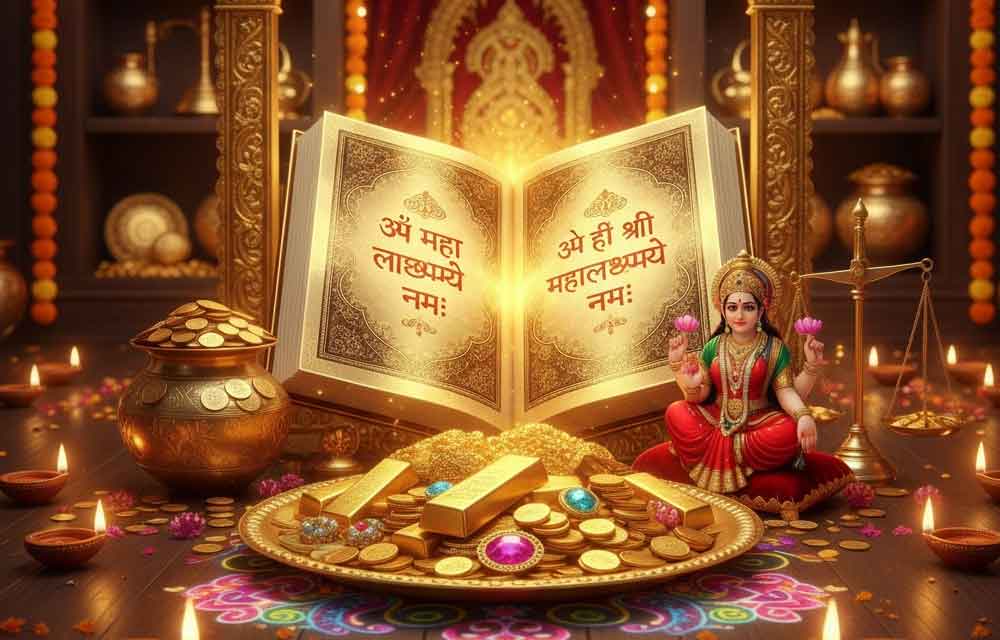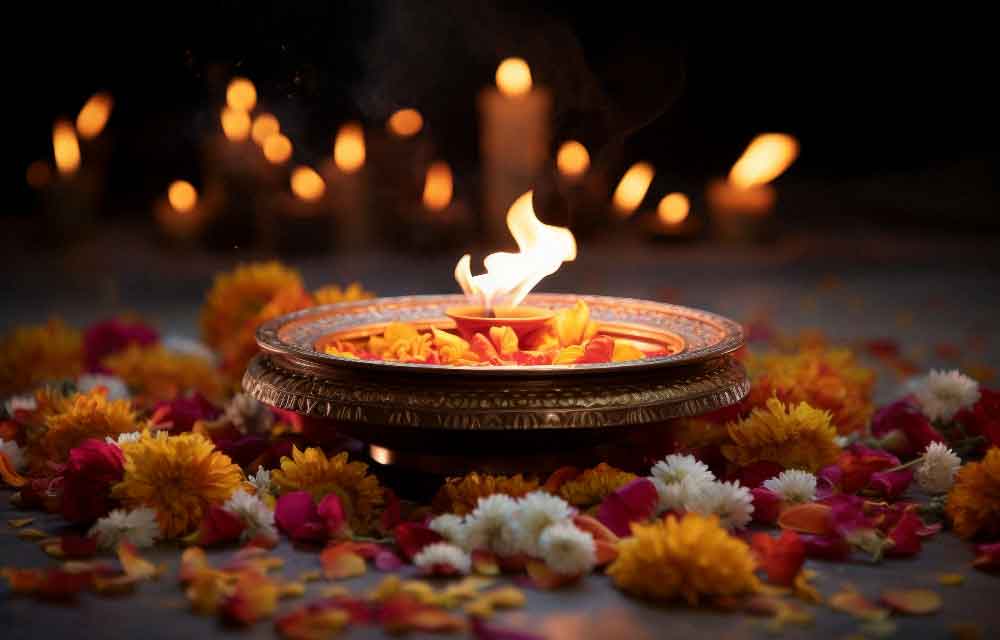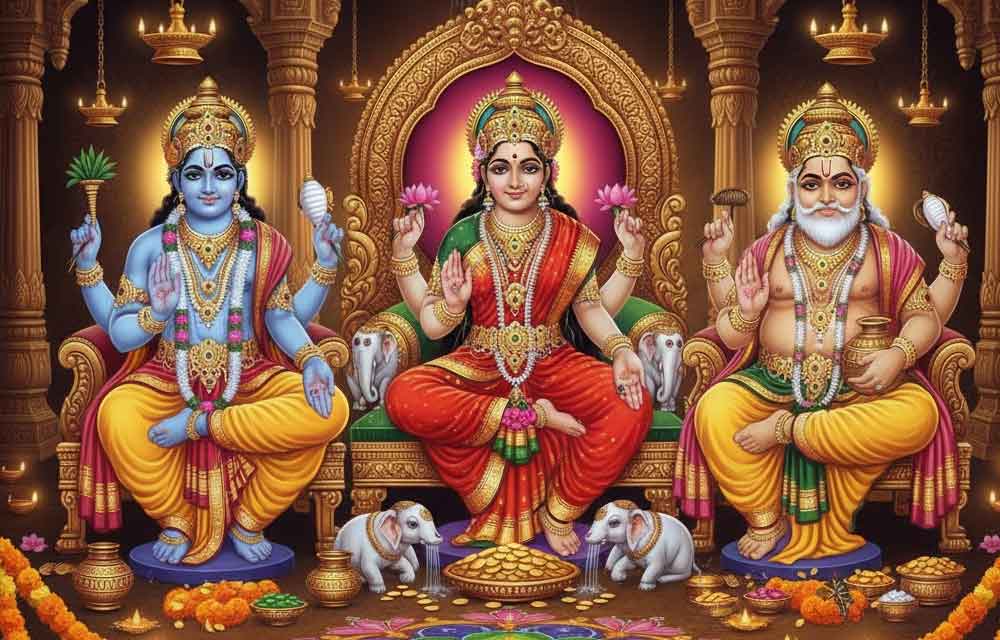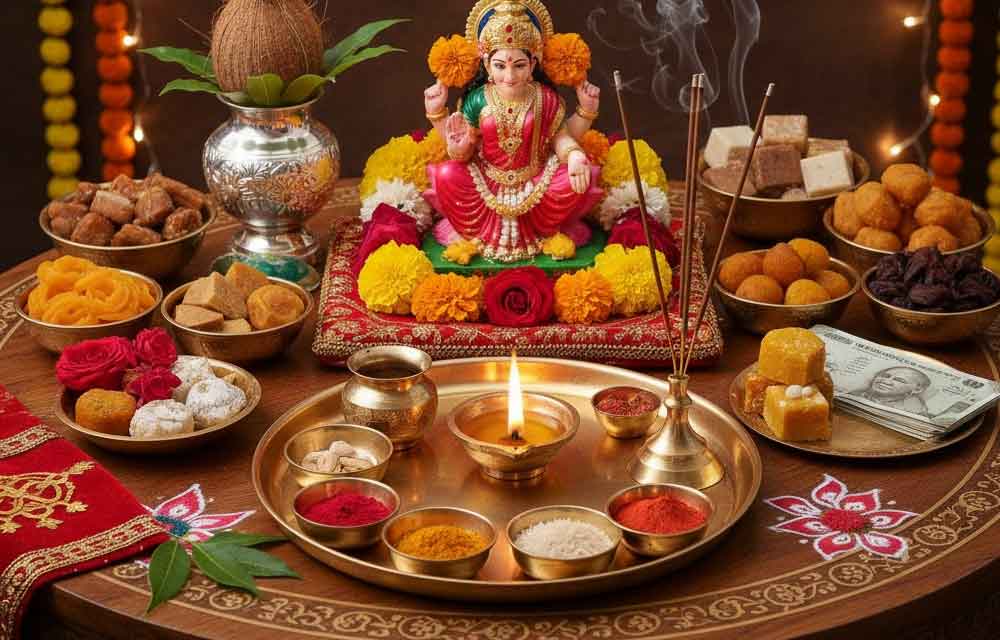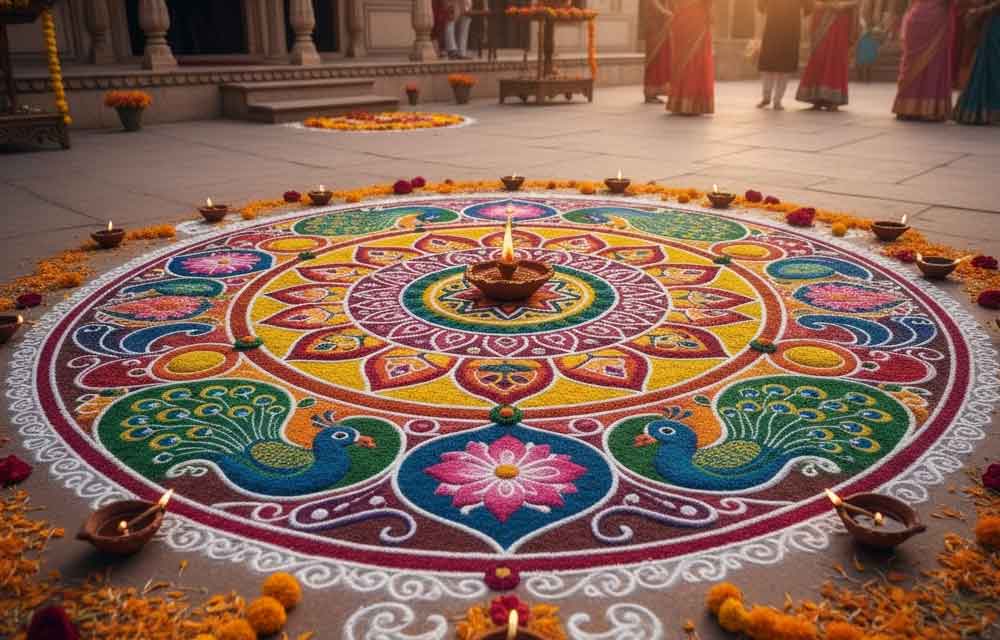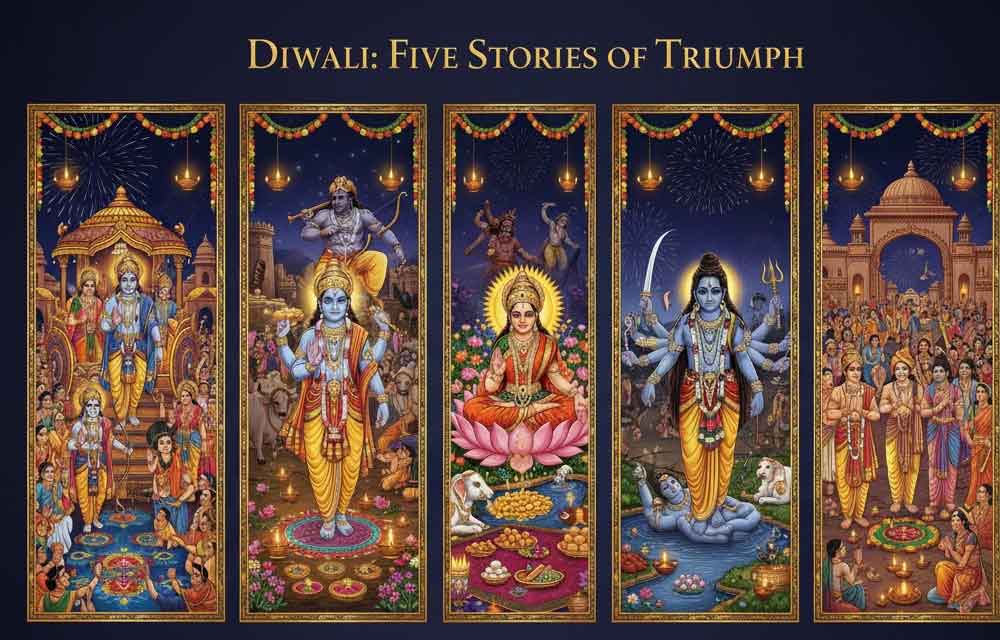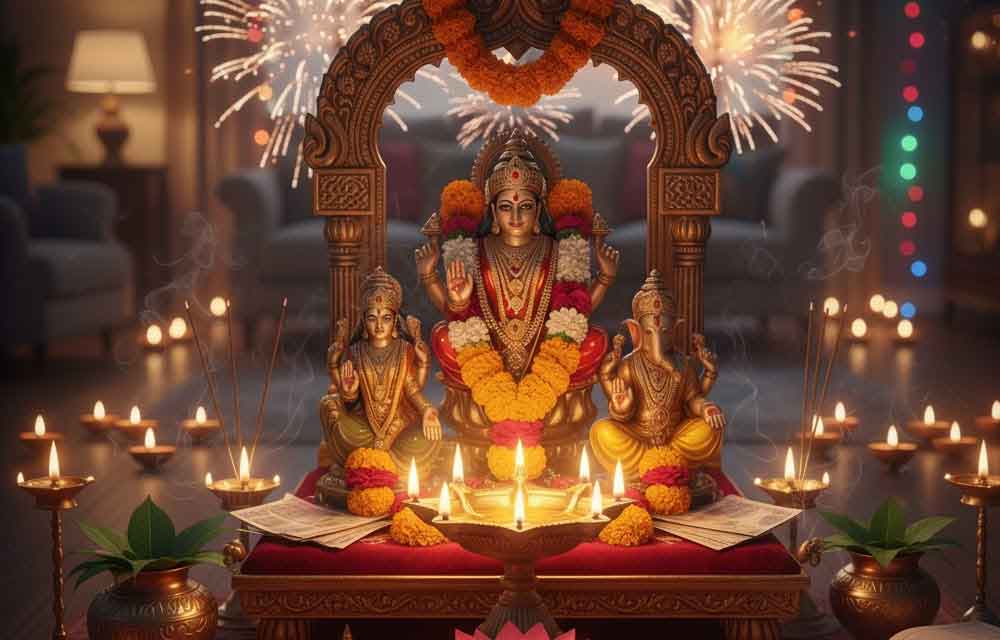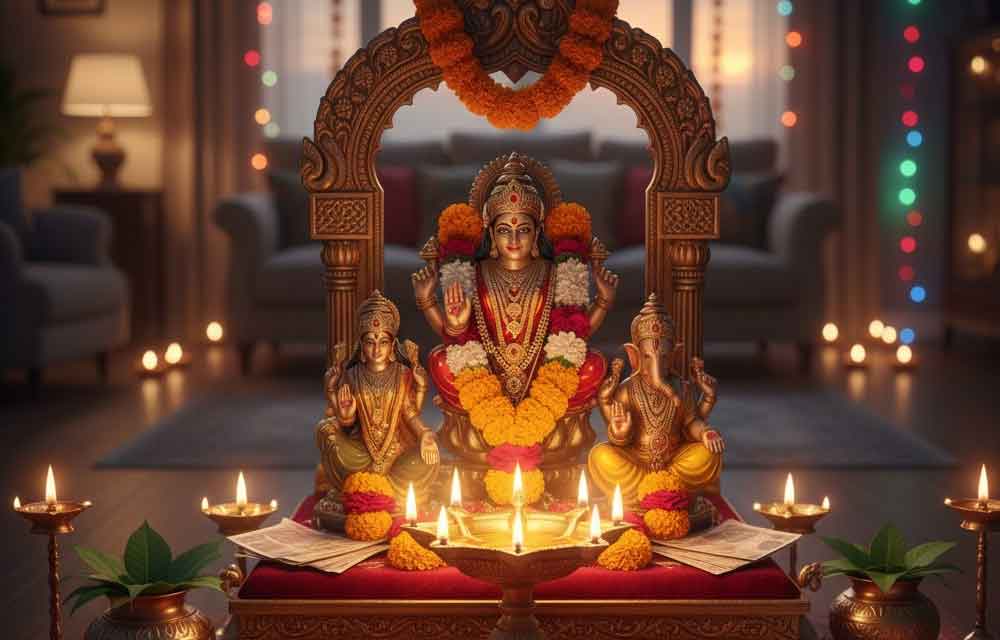Step-by-Step Guide to Performing Lakshmi Puja on Diwali 2025
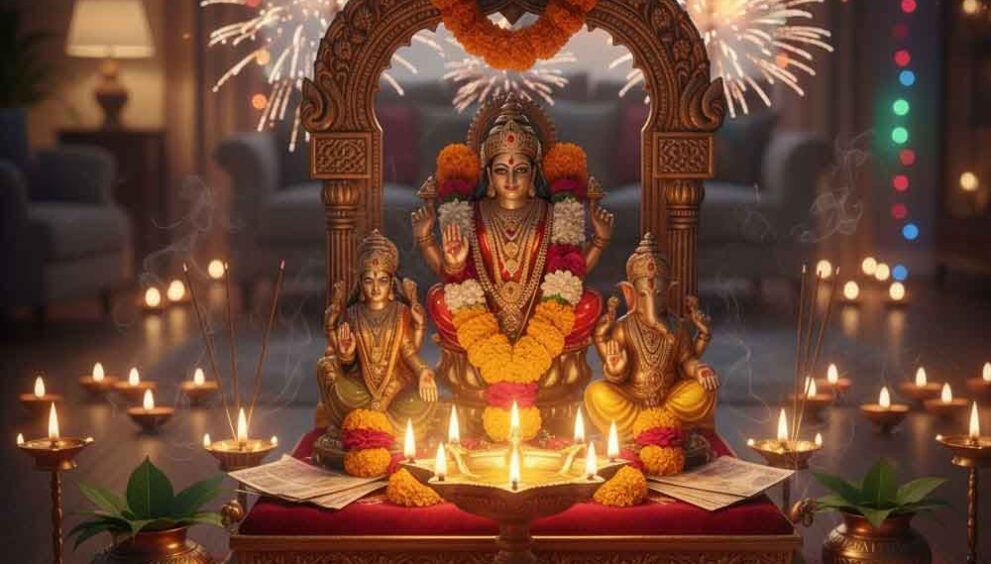
Complete Ritual Guide with Mantras and Their Sacred Meanings
Diwali, the Festival of Lights, reaches its pinnacle with Lakshmi Puja—the worship of Goddess Lakshmi, the deity of wealth, prosperity, and abundance. In 2025, Lakshmi Puja falls on Monday, October 20th, during the auspicious Amavasya (new moon) night. This comprehensive guide will walk you through every step of the sacred ritual, ensuring you perform the puja with devotion and proper understanding.
When to Perform Lakshmi Puja in 2025
Date: Monday, October 20, 2025
Auspicious Muhurat (Best Time): 6:10 PM to 8:40 PM
Amavasya Tithi Begins: October 20, 3:44 PM
Amavasya Tithi Ends: October 21, 5:54 PM
The most auspicious time for Lakshmi Puja is during Pradosh Kaal, which starts after sunset and lasts approximately 2 hours and 24 minutes. This is considered the most spiritually potent time to invoke the goddess.
Why Do We Perform Lakshmi Puja on Diwali?
According to Hindu mythology, Goddess Lakshmi emerged from the cosmic ocean during the churning of the milk sea (Samudra Manthan) on the new moon night of Kartik month. On this sacred night, she chose Lord Vishnu as her consort. Diwali commemorates this divine event, and devotees believe that Lakshmi visits clean, well-lit homes on this night, bestowing prosperity and removing poverty.
The festival also celebrates Lord Rama’s return to Ayodhya after 14 years of exile, when the entire kingdom illuminated with diyas to welcome their beloved king.
Pre-Puja Preparations
House Cleaning and Decoration
- Deep clean your entire home at least 2-3 days before Diwali, especially the puja room
- Declutter all spaces—Goddess Lakshmi is said to avoid untidy environments
- Decorate your entrance with fresh rangoli patterns using colored powders, flowers, or rice
- Light diyas (oil lamps) at the entrance, in the puja room, and around your home
- Hang mango leaves and marigold garlands at doorways for auspiciousness
Essential Puja Items (Samagri)
For the Altar:
- Idol or picture of Goddess Lakshmi and Lord Ganesha
- Clean red or yellow cloth for the altar
- Wooden chowki (low platform) or table
- Kalash (copper or brass pot filled with water)
- Mango leaves to place on kalash
- Coconut to place on kalash
Puja Materials:
- Fresh flowers (lotus, marigold, roses)
- Incense sticks (agarbatti) and dhoop
- Ghee or oil diyas with cotton wicks
- Kumkum (vermillion) and turmeric
- Unbroken rice grains (Akshat)
- Sandalwood paste
- Betel leaves and nuts
- Sacred thread (Moli/Kalawa)
- Camphor for aarti
- Bell
Offerings (Bhog):
- Fresh seasonal fruits
- Sweets (especially kheer, ladoos, barfi)
- Dry fruits (almonds, cashews, raisins)
- Silver or gold coins (real or symbolic)
- New currency notes
Additional Items:
- New account books or business ledgers
- Jewelry and ornaments to be blessed
- Musical instruments (for worship)
Step-by-Step Lakshmi Puja Procedure
Step 1: Personal Purification
Begin by taking a bath and wearing clean, preferably new clothes. Red, yellow, orange, or green colors are considered auspicious for Diwali. Ensure all family members are ready before the muhurat time.
Step 2: Setting Up the Altar
- Cover the chowki with a clean cloth
- Place a handful of rice grains on the cloth and position the Lakshmi-Ganesha idol or picture
- Fill the kalash with water, place mango leaves around its mouth, and top it with a coconut
- Position the kalash to the right side of the deities
- Draw a lotus or swastika symbol with kumkum in front of the deities
Step 3: Invocation of Lord Ganesha (Ganesh Pujan)
Always begin by worshiping Lord Ganesha to remove obstacles from the puja.
Ganesh Mantra:
ॐ गं गणपतये नमः
Om Gam Ganapataye Namah
Meaning: I bow to Lord Ganesha, the remover of obstacles and lord of new beginnings.
Light a diya and incense. Offer flowers, kumkum, rice, and modak (or any sweet) to Ganesha while chanting his mantra 11 times.
Step 4: Kalash Sthapana (Installation of Sacred Pot)
The kalash represents the universe and divine presence.
Kalash Mantra:
ॐ कलशस्य मुखे विष्णुः कण्ठे रुद्रः समाश्रितः।
मूले तत्र स्थितो ब्रह्मा मध्ये मातृगणाः स्मृताः।
Om Kalashaya Mukhe Vishnuh Kanthe Rudrah Samashritah
Moole Tatra Sthito Brahma Madhye Matriganah Smritah
Meaning: At the mouth of the kalash resides Vishnu, at the neck Rudra (Shiva), at the base Brahma, and in the middle the divine mother goddesses.
Sprinkle water from the kalash on yourself and the puja items for purification.
Step 5: Invoking Goddess Lakshmi (Lakshmi Avahan)
This is the main ritual where you invite the goddess into your home.
Lakshmi Avahan Mantra:
ॐ श्रीं ह्रीं श्रीं कमले कमलालये प्रसीद प्रसीद
श्रीं ह्रीं श्रीं ॐ महालक्ष्म्यै नमः
Om Shreem Hreem Shreem Kamale Kamalalaye Praseed Praseed
Shreem Hreem Shreem Om Mahalakshmyai Namah
Meaning: I bow to Goddess Mahalakshmi, the one who resides in the lotus. Please be pleased and bless me with your presence.
Visualize the goddess arriving in her divine form, adorned with gold ornaments, seated on a lotus, with gold coins flowing from her hands.
Step 6: Pancha Puja (Five Forms of Offering)
Offer these five elements to please the goddess:
- Gandha (Sandalwood paste): Apply to the deity’s feet
- Pushpa (Flowers): Offer fresh flowers, especially lotus and marigold
- Dhoop (Incense): Wave incense sticks in a circular motion
- Deep (Lamp): Light ghee diyas and offer them
- Naivedya (Food): Present the prepared sweets and fruits
Step 7: Shodashopachara (16 Sacred Offerings)
For an elaborate puja, perform these sixteen traditional offerings:
- Dhyan (Meditation on the deity)
- Avahan (Invocation)
- Asana (Offering a seat)
- Padya (Water for washing feet)
- Arghya (Water for welcoming)
- Achamana (Water to sip)
- Snana (Ceremonial bath with water/milk)
- Vastra (Offering cloth)
- Abharana (Offering ornaments)
- Gandha (Sandalwood paste)
- Pushpa (Flowers)
- Dhoop (Incense)
- Deep (Lamp)
- Naivedya (Food offerings)
- Tambula (Betel leaves and nuts)
- Dakshina (Offering of coins)
Step 8: Chanting Lakshmi Mantras
Recite these powerful mantras to invoke the goddess’s blessings:
Mahalakshmi Ashtakam (First Verse):
नमस्तेस्तु महामाये श्रीपीठे सुरपूजिते।
शङ्खचक्रगदाहस्ते महालक्ष्मि नमोऽस्तु ते॥
Namaste'stu Mahamaye Shripeethe Surapujite
Shankhachakragadahaste Mahalakshmi Namo'stu Te
Meaning: I bow to you, O Mahalakshmi, who is revered by gods, seated on the throne of prosperity, holding the conch, discus, and mace.
Lakshmi Gayatri Mantra:
ॐ महालक्ष्म्यै च विद्महे विष्णुपत्न्यै च धीमहि।
तन्नो लक्ष्मीः प्रचोदयात्॥
Om Mahalakshmyai Cha Vidmahe Vishnupatnyai Cha Dheemahi
Tanno Lakshmih Prachodayat
Meaning: We meditate on Goddess Mahalakshmi, the consort of Lord Vishnu. May she illuminate our consciousness and guide us toward prosperity.
Lakshmi Beej Mantra:
ॐ श्रीं श्रीं श्रीं महालक्ष्म्यै नमः
Om Shreem Shreem Shreem Mahalakshmyai Namah
Meaning: I bow to Mahalakshmi. (“Shreem” is the seed sound that embodies all forms of abundance and prosperity.)
Chant any of these mantras 108 times using a mala (rosary) for maximum benefit.
Step 9: Lakshmi Aarti
Perform the aarti with camphor or ghee lamps, moving them in circular clockwise motions in front of the deity. Sing the traditional Lakshmi Aarti:
Om Jai Lakshmi Mata (First Verse):
ॐ जय लक्ष्मी माता, मैया जय लक्ष्मी माता।
तुमको निस दिन सेवत, हर विष्णु विधाता॥
Om Jai Lakshmi Mata, Maiya Jai Lakshmi Mata
Tumko Nis Din Sevat, Har Vishnu Vidhata
Meaning: Glory to Mother Lakshmi! Lord Vishnu, the creator, worships you day and night.
Ring the bell throughout the aarti and invite all family members to join in singing.
Step 10: Offering Bhog (Prasad)
Present the prepared sweets, fruits, and special dishes to the goddess. Traditional offerings include:
- Kheer (rice pudding made with milk and sugar)
- Malpua (sweet pancakes)
- Dry fruits
- Coconut ladoos
- Seasonal fruits
Sprinkle water around the plate while chanting:
ॐ प्राणाय स्वाहा, अपानाय स्वाहा, व्यानाय स्वाहा,
उदानाय स्वाहा, समानाय स्वाहा, ब्रह्मणे स्वाहा
Step 11: Lakshmi Chalisa or Stotram
For deeper devotion, recite the Lakshmi Chalisa (40 verses) or Mahalakshmi Stotra. These hymns narrate the goddess’s qualities and manifestations.
Step 12: Pushpanjali (Flower Offering)
Take flowers in both hands, close your eyes, and meditate on the goddess. Offer the flowers at her feet while making your personal prayers and wishes for prosperity, health, and family welfare.
Step 13: Pradakshina (Circumambulation)
Walk around the altar in a clockwise direction three times as a mark of respect and surrender.
Step 14: Prarthana (Prayer)
Offer your heartfelt prayers:
Closing Prayer:
या देवी सर्वभूतेषु लक्ष्मी रूपेण संस्थिता।
नमस्तस्यै नमस्तस्यै नमस्तस्यै नमो नमः॥
Ya Devi Sarvabhuteshu Lakshmi Rupena Samsthita
Namastasyai Namastasyai Namastasyai Namo Namah
Meaning: I bow again and again to the goddess who resides in all beings in the form of Lakshmi (prosperity and abundance).
Step 15: Distribution of Prasad
Distribute the blessed prasad to all family members and guests. Keep some prasad for the next day as well.
Step 16: Coin and Book Worship
Place your purse, jewelry, account books, and business ledgers near the deity. Businesspeople traditionally worship their account books on this day, marking the beginning of a new financial year.
Special Mantras and Their Deep Meanings
For Wealth and Prosperity
ॐ ह्रीं श्रीं क्रीं श्रीं क्रीं क्लीं श्रीं महालक्ष्म्यै नमः
Om Hreem Shreem Kreem Shreem Kreem Kleem Shreem Mahalakshmyai Namah
Meaning: This powerful combination of seed syllables invokes wealth (Shreem), divine grace (Hreem), transformation (Kreem), and desire fulfillment (Kleem).
For Removing Poverty
ॐ ह्रीं श्रीं क्लीं त्रिभुवन महालक्ष्म्यै अस्माकम् दारिद्र्य नाशय प्रचुर धन देहि देहि क्लीं ह्रीं श्रीं ॐ
Om Hreem Shreem Kleem Tribhuvana Mahalakshmyai Asmakam Daridra Nashaya Prachura Dhana Dehi Dehi Kleem Hreem Shreem Om
Meaning: O Mahalakshmi of the three worlds, destroy our poverty and bestow abundant wealth upon us.
For Business Success
ॐ श्रीं ह्रीं क्लीं महालक्ष्मी नमः
Om Shreem Hreem Kleem Mahalakshmi Namah
Meaning: A simple yet powerful mantra for attracting business opportunities and financial growth.
Post-Puja Rituals and Traditions
Keep Lights Burning
Maintain at least one diya burning throughout the night. This symbolizes keeping the path lit for Goddess Lakshmi to enter your home.
Gambling and Games
Playing cards or dice on Diwali night is considered auspicious, as it’s believed Goddess Parvati played dice with Lord Shiva on this night and blessed devotees with prosperity.
Fire Crackers (Optional)
While many light firecrackers, consider eco-friendly alternatives to protect the environment and animals. The true light of Diwali comes from within.
Charity and Giving
Donate food, clothes, or money to those in need. Sharing your blessings multiplies them.
Avoid These During Puja
- Using onion or garlic in prasad or meals
- Wearing black clothes
- Arguing or speaking harshly
- Negative thoughts or complaints
- Leaving the house dirty or cluttered
Regional Variations in Lakshmi Puja
North India
Focuses heavily on Lakshmi-Ganesha worship together, emphasizing Lord Rama’s return to Ayodhya.
Bengal
Celebrates Kali Puja on the same night, worshiping Goddess Kali along with or instead of Lakshmi.
Gujarat
Marks the beginning of the new year on this day. Business communities perform elaborate pujas of account books.
South India
Some regions celebrate Naraka Chaturdashi (the day before) as the main festival, commemorating Krishna’s victory over the demon Narakasura.
Maharashtra
Performs Lakshmi Puja with special emphasis on worshiping ancestors and lighting diyas for departed souls.
Benefits of Performing Lakshmi Puja with Devotion
- Financial Prosperity: Attracts wealth and removes financial obstacles
- Family Harmony: Brings peace and happiness to the household
- Business Success: Opens new opportunities and ensures growth
- Spiritual Growth: Develops gratitude and contentment
- Health and Wellbeing: Goddess Lakshmi’s eight forms include Dhanya Lakshmi (food) and Arogya Lakshmi (health)
- Protection: Shields the family from negativity and evil influences
- Mental Peace: Reduces stress and anxiety about the future
- Good Fortune: Attracts positive circumstances and helpful people
Tips for First-Time Performers
- Don’t Stress: Your devotion matters more than perfect execution
- Learn Pronunciation: Use YouTube or audio guides for correct mantra pronunciation
- Start Simple: If the full ritual seems overwhelming, begin with basic puja and gradually expand
- Include Children: Make it a family activity to pass on traditions
- Prepare in Advance: Gather all materials a day before to avoid last-minute rushing
- Set Your Intention: Begin with a clear, positive intention for what you seek
- Stay Present: Focus on each step rather than worrying about the next
- Seek Guidance: Ask elders or consult a priest if you have doubts
Common Mistakes to Avoid
- Starting puja before the muhurat or after it ends
- Using stale flowers or food items
- Performing puja in unclean clothes or space
- Rushing through mantras without understanding
- Forgetting to worship Ganesha first
- Using synthetic or artificial flowers
- Not keeping account books and cash for blessing
- Extinguishing all diyas immediately after puja
Frequently Asked Questions
Q: Can I perform Lakshmi Puja if I’m alone?
A: Absolutely. Individual worship is equally powerful. Follow the steps with devotion.
Q: What if I miss the muhurat time?
A: You can perform the puja during Pradosh Kaal, which extends for about 2.5 hours after sunset.
Q: Are non-vegetarian meals allowed on Diwali?
A: Traditional practice suggests pure vegetarian meals on this sacred day, especially before and during puja.
Q: Can women perform the puja during menstruation?
A: Modern interpretation allows it, as devotion knows no barriers. However, some families follow traditional restrictions.
Q: How long should the puja last?
A: A basic puja takes 30-45 minutes. Elaborate ceremonies may last 1-2 hours.
Q: What to do with flowers after puja?
A: Immerse them respectfully in flowing water or bury them in soil. Never throw them in the trash.
Conclusion: Welcoming Abundance with an Open Heart
Lakshmi Puja is more than a ritual—it’s a sacred invitation to welcome prosperity in all its forms into your life. When performed with genuine devotion, proper understanding, and a clean heart, this ancient practice creates a powerful spiritual atmosphere that resonates throughout the year.
Remember, Goddess Lakshmi represents not just material wealth but also spiritual abundance, health, knowledge, courage, and progeny. Her worship teaches us gratitude for what we have and cultivates the mindset of abundance rather than scarcity.
As you light the diyas this Diwali, may your home be filled with the divine presence of Goddess Lakshmi. May prosperity flow into your life like the eternal stream of wealth from her lotus hands. May darkness be dispelled by light, ignorance by wisdom, and poverty by abundance.
Wishing you and your family a blessed, prosperous, and illuminated Diwali 2025!
Share this guide with your family and friends to help them perform an authentic Lakshmi Puja this Diwali. For more Hindu festival guides, rituals, and spiritual content, visit www.hindutone.com.
Jai Maa Lakshmi! Happy Diwali!

 English
English 







